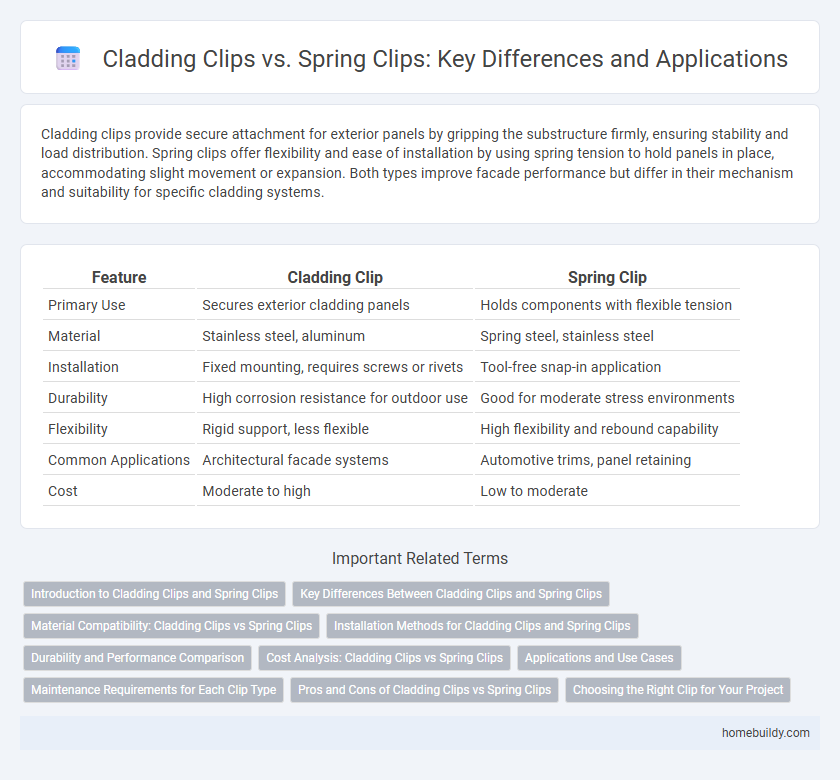Cladding clips provide secure attachment for exterior panels by gripping the substructure firmly, ensuring stability and load distribution. Spring clips offer flexibility and ease of installation by using spring tension to hold panels in place, accommodating slight movement or expansion. Both types improve facade performance but differ in their mechanism and suitability for specific cladding systems.
Table of Comparison
| Feature | Cladding Clip | Spring Clip |
|---|---|---|
| Primary Use | Secures exterior cladding panels | Holds components with flexible tension |
| Material | Stainless steel, aluminum | Spring steel, stainless steel |
| Installation | Fixed mounting, requires screws or rivets | Tool-free snap-in application |
| Durability | High corrosion resistance for outdoor use | Good for moderate stress environments |
| Flexibility | Rigid support, less flexible | High flexibility and rebound capability |
| Common Applications | Architectural facade systems | Automotive trims, panel retaining |
| Cost | Moderate to high | Low to moderate |
Introduction to Cladding Clips and Spring Clips
Cladding clips are specifically designed to securely fasten exterior wall panels, providing strong support while allowing for thermal expansion and contraction. Spring clips offer a flexible fastening solution that accommodates movement and vibration, often used in applications requiring easy installation and removal. Both clamp types enhance facade durability but serve distinct functions based on material compatibility and structural needs.
Key Differences Between Cladding Clips and Spring Clips
Cladding clips secure exterior panels with a rigid, fixed grip, ensuring dimensional stability and resistance to wind loads, whereas spring clips use flexible tension to accommodate panel movement and thermal expansion. Cladding clips typically provide stronger mechanical fastening suitable for heavier materials, while spring clips offer easier panel installation and removal due to their resilient design. Material compatibility and load-bearing capacity are critical factors distinguishing the choice between cladding clips and spring clips in building envelope applications.
Material Compatibility: Cladding Clips vs Spring Clips
Cladding clips are typically made from stainless steel or aluminum alloys, ensuring high corrosion resistance and durability on diverse materials like metal, wood, and composite panels. Spring clips often utilize spring steel or galvanized steel, providing strong grip and flexibility but may face compatibility issues with highly corrosive or acidic cladding materials. Material compatibility favors cladding clips for long-term exposure to harsh environments, while spring clips excel in applications requiring frequent dismantling or adjustments.
Installation Methods for Cladding Clips and Spring Clips
Cladding clips are typically installed using mechanical fasteners, such as screws or rivets, which secure the clip directly to the building substrate, providing a rigid and durable attachment for architectural panels. In contrast, spring clips rely on their inherent tension to grip the panel edges and frame, allowing for quicker, tool-free installation that accommodates panel movement and thermal expansion. The installation method for cladding clips demands precise alignment and fastening, whereas spring clips offer flexibility and ease in adjusting or replacing panels without removing the entire clip system.
Durability and Performance Comparison
Cladding clips offer superior durability compared to spring clips due to their robust steel construction and corrosion-resistant coatings, enhancing long-term performance in harsh weather conditions. While spring clips provide flexibility and ease of installation, cladding clips maintain consistent tension, reducing the risk of panel movement or deformation over time. This reliability makes cladding clips a preferred choice for high-performance architectural facades requiring sustained structural integrity.
Cost Analysis: Cladding Clips vs Spring Clips
Cladding clips generally offer a cost-effective solution compared to spring clips due to lower material and manufacturing expenses, making them ideal for large-scale facade installations. Spring clips, while often more durable and providing better elasticity, tend to incur higher initial costs and maintenance expenses over time. Evaluating project-specific requirements and budget constraints is crucial to determining the most economical choice between cladding clips and spring clips.
Applications and Use Cases
Cladding clips provide secure and durable fastening solutions for architectural panels, ideal for exterior facades requiring weather resistance and high load-bearing capacity. Spring clips offer flexibility and ease of installation, suited for interior applications or lightweight materials where vibration absorption and quick assembly are priorities. Both clip types enhance facade performance but differ in their optimal use cases based on environmental exposure and structural requirements.
Maintenance Requirements for Each Clip Type
Cladding clips generally require less maintenance due to their durable corrosion-resistant materials and secure fastening systems, which reduce the risk of loosening or damage over time. Spring clips, while offering flexibility and ease of installation, may need more frequent inspections and adjustments to ensure tension and alignment are maintained under varying environmental conditions. Selecting between cladding and spring clips depends on balancing long-term durability with ease of upkeep in specific building envelope applications.
Pros and Cons of Cladding Clips vs Spring Clips
Cladding clips offer strong durability and enhanced load-bearing capacity, making them ideal for heavy facade panels, whereas spring clips provide flexible installation and easier removal suited for lightweight materials. Cladding clips typically ensure better weather resistance and long-term stability but require more precise alignment and can increase installation time. Spring clips facilitate quick assembly and adjustability but may lack the robust support and longevity of cladding clips in demanding exterior conditions.
Choosing the Right Clip for Your Project
Cladding clips provide superior stability and corrosion resistance compared to spring clips, making them ideal for long-term exterior applications. Spring clips offer easier installation and flexibility but may compromise durability under harsh weather conditions. Selecting the right clip depends on project requirements such as material compatibility, environmental exposure, and maintenance needs.
Cladding clip vs Spring clip Infographic

 homebuildy.com
homebuildy.com